Veterinary Healthcare Market
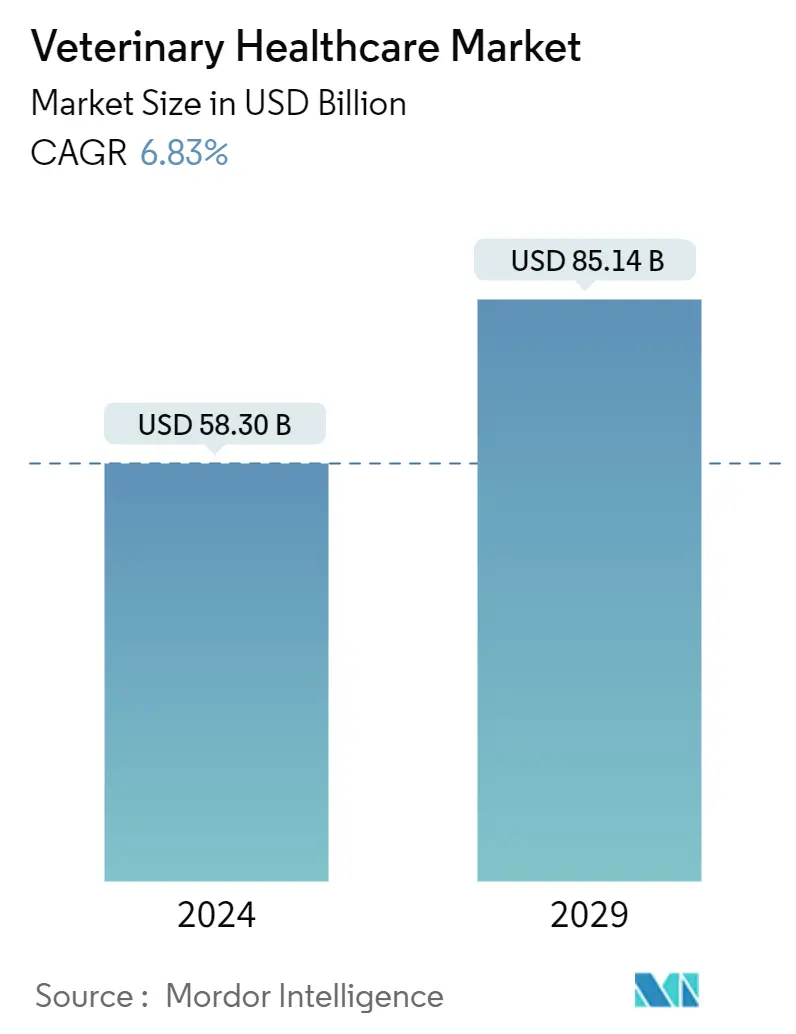
| Study Period | 2019 - 2029 |
| Market Size (2024) | USD 58.30 Billion |
| Market Size (2029) | USD 85.14 Billion |
| CAGR (2024 - 2029) | 6.83 % |
| Fastest Growing Market | Asia-Pacific |
| Largest Market | North America |
| Market Concentration | Medium |
Major Players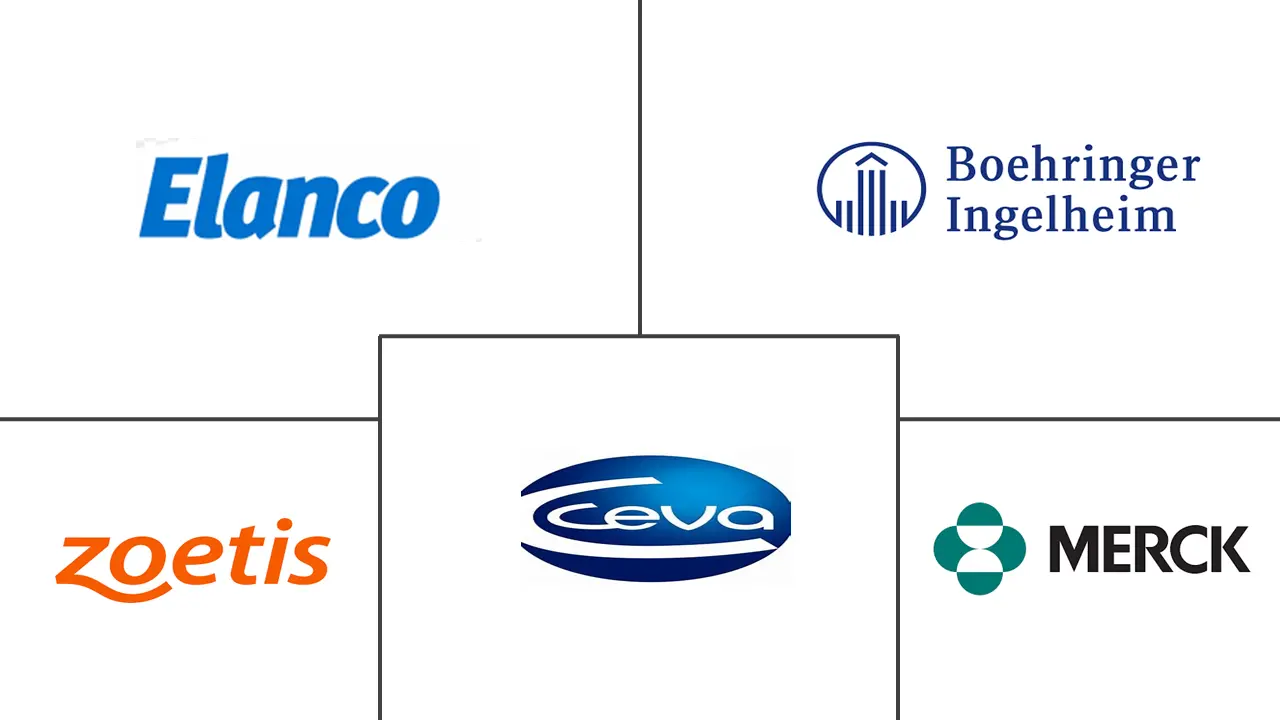
*Disclaimer: Major Players sorted in no particular order |
Veterinary Healthcare Market Analysis
The Veterinary Healthcare Market size is estimated at USD 58.30 billion in 2024, and is expected to reach USD 85.14 billion by 2029, growing at a CAGR of 6.83% during the forecast period (2024-2029).
The major factors driving the market are the increasing prevalence of zoonotic diseases, rising awareness of animal health, technological advancements in animal healthcare diagnostics, and increasing government initiatives by the Global Veterinary Medical Association.
Zoonotic diseases are infections that are spread between people and animals. The rising prevalence of zoonotic diseases will likely drive market growth during the forecast period. For instance, in the study published by the Federal Research Institute for Animal Health in January 2024, between December 1 and December 31, 2023, 13 HPAIV H5 outbreaks were detected in domestic poultry in Germany. The number of Avian Influenza cases in wild birds increased in 2023 compared to 2022. In addition, according to the study published by the European Centre for Disease Prevention and Control, between June 24 and September 1, 2023, highly pathogenic avian influenza (HPAI) A(H5) outbreaks were reported in domestic and wild birds across 21 countries in Europe. Hence, the rising prevalence of zoonotic disease worldwide will lead to more focus on animal health, ultimately increasing the demand for veterinary healthcare.
The growing technological advancements in animal healthcare diagnostics are expected to drive the market. For instance, in November 2023, IDEXX Laboratories Inc. launched the SNAP Leish 4Dx test, a comprehensive screening test for vector-borne diseases, including canine leishmaniosis. The new test was expected to be available in Europe and Asia starting from February 2024. In June 2023, IDEXX launched the first test for detecting kidney injury in cats and dogs called the IDEXX Cystatin B test. Hence, the rising technological advancements in animal healthcare are expected to drive the market during the forecast period.
However, the high cost of diagnostic imaging equipment and veterinary medicines and the high price of veterinary services are anticipated to restrain market growth over the forecast period.
Veterinary Healthcare Market Trends
The Vaccine Segment Expected to Hold a Significant Share Over the Forecast Period
Vaccines are comprised of viruses, bacteria, or other disease-causing organisms that have been killed or altered so that they cannot cause any disease. The primary goals of veterinary vaccines are to improve the health and welfare of companion animals, increase the production of livestock in a cost-effective manner, and prevent animal-to-human transmission from both domestic animals and wildlife. Factors such as the rising prevalence of zoonotic diseases, increasing cattle population, increasing pet adoption rates worldwide, and new product launches are expected to boost the segment growth during the forecast period.
The growing number of cattle populations worldwide, prevalent in several bacterial and viral diseases, is likely to boost the segment’s growth. For instance, according to the UN Food and Agriculture Organization data published in July 2023, there were 1.52 billion cattle worldwide in 2022. The escalating global cattle population, coupled with their susceptibility to various bacterial and viral diseases, is anticipated to drive the growth of the vaccine segment over the forecast period. Additionally, various initiatives taken by the government to vaccinate animals against various diseases are expected to boost the segment’s growth. In January 2022, Indonesia initiated a statewide livestock vaccination program as the number of cattle infected with foot and mouth disease increased to more than 151,000.
Market players are developing and launching new vaccines and increasing strategic activities globally to enhance their market presence. For instance, in June 2023, Merck Animal Health launched the Circumvent CML vaccine. It is a three-in-one vaccine for Porcine Circovirus Type 2a (PCV-2a), Porcine Circovirus Type 2d (PCV-2d), and Mycoplasma hyopneumoniae and Lawsonia intracellularis. In addition, in January 2023, Merck Animal Health opened a state-of-the-art manufacturing facility in Boxmeer, the Netherlands, for Companion Animal vaccines. The location is part of a manufacturing network in the Netherlands, including existing production and research facilities in Boxmeer. This new manufacturing unit was expected to help the company expand its veterinary vaccine market across Europe.
Therefore, the rising prevalence of zoonotic diseases, increasing cattle population, increasing pet adoption rates worldwide, and increasing product launches and strategic activities by market players are expected to drive the vaccine segment during the forecast period.
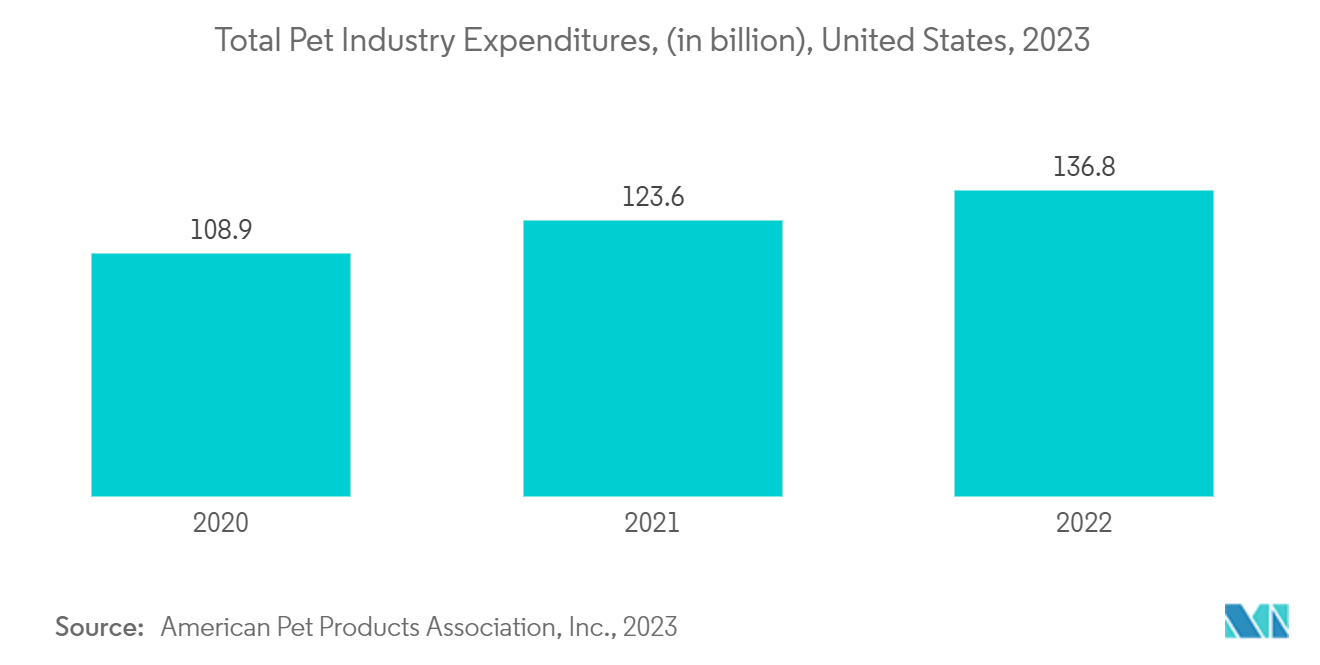
North America is Expected to Hold the Largest Market Share over the Forecast Period
North America is one of the most developed regions in the world. It currently holds the major share of the veterinary healthcare market, and it is expected to follow the same trend over the forecast period. With increasing initiatives by various organizations in North American countries and high pet adoption, the market is expected to record strong growth.
Increasing initiatives by various organizations and high pet adoptions are expected to boost the market’s growth. For instance, according to Pet Food Industry data, in 2022, around 398,477 dogs were adopted compared to around 393,712 dogs adopted in 2021. Similarly, 528,526 cats were adopted from shelters in 2021, rising to 539,015 in 2022. The adoption rate for dogs and cats grew by 1.2% and 2%, respectively, in 2022 compared to the adoption rate in 2021. The rising adoption rate of pets implies increased expenditure on pet health by new owners, which is expected to drive the veterinary health market during the forecast period.
In August 2022, the California Animal Welfare Funders Collaborative (CAWFC) awarded USD 300,000 in grants to 19 organizations to provide pets with proper food, medicines, and diagnostics as required. Additionally, according to Canadian Animal Health Institute 2023 statistics, pet ownership in Canada increased throughout the pandemic, with 60% of households reporting ownership of at least one cat or dog. During 2020-2022, the number of pets in Canada increased from 7.7 million to 7.9 million for dogs and from 8.1 million to 8.5 million for cats. Also, pet healthcare expenditure increased, with 17% of owners willing to spend more than USD 500 every year for their pet healthcare. The rising pet adoption and increasing willingness to spend more on pet healthcare are expected to boost market growth during the forecast period.
Strategic initiatives by market players are expected to propel market growth in the region during the forecast period. For instance, in September 2022, Boehringer Ingelheim pledged to donate approximately 100,000 doses of rabies vaccination to help prevent rabies in dogs. The donation was expected to be used in tribal territories and underserved communities across the United States as part of the relaunched SHOTS FOR GOOD program.
Therefore, owing to the aforementioned factors, such as the rising pet adoption in North America, increasing per capita animal healthcare expenditure, and increasing product launches, the demand for veterinary products is expected to increase in North America, enhancing the growth of the market in North America.
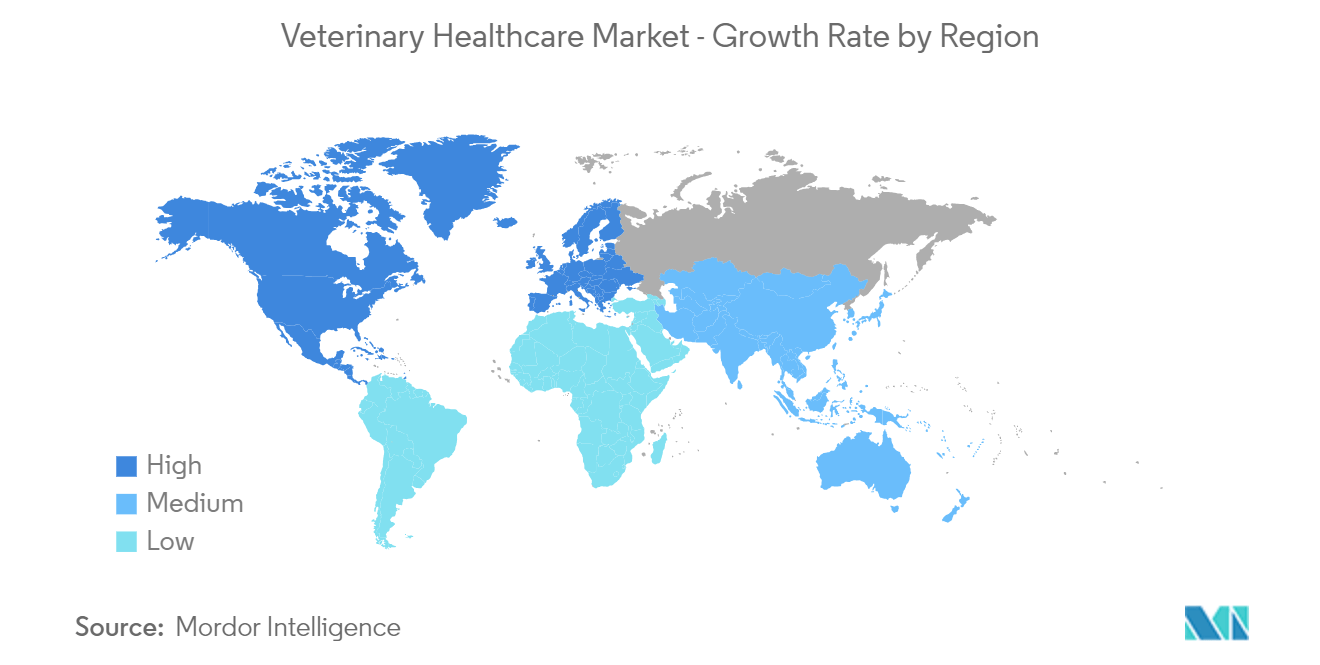
Veterinary Healthcare Industry Overview
The veterinary healthcare market is fragmented, with the presence of several key players. Major companies have undertaken several business strategies to gain a competitive edge, such as regional expansion, mergers and acquisitions, and collaborative research initiatives. Some of the key players in the market include Elanco Animal Health Incorporated, Boehringer Ingelheim International GmbH, Vetoquinol SA, Zoetis Inc., and IDEXX Laboratories.
Veterinary Healthcare Market Leaders
-
Zoetis Inc.
-
Boehringer Ingelheim International GmbH
-
Elanco Animal Health
-
Ceva
-
Merck & Co., Inc.
*Disclaimer: Major Players sorted in no particular order
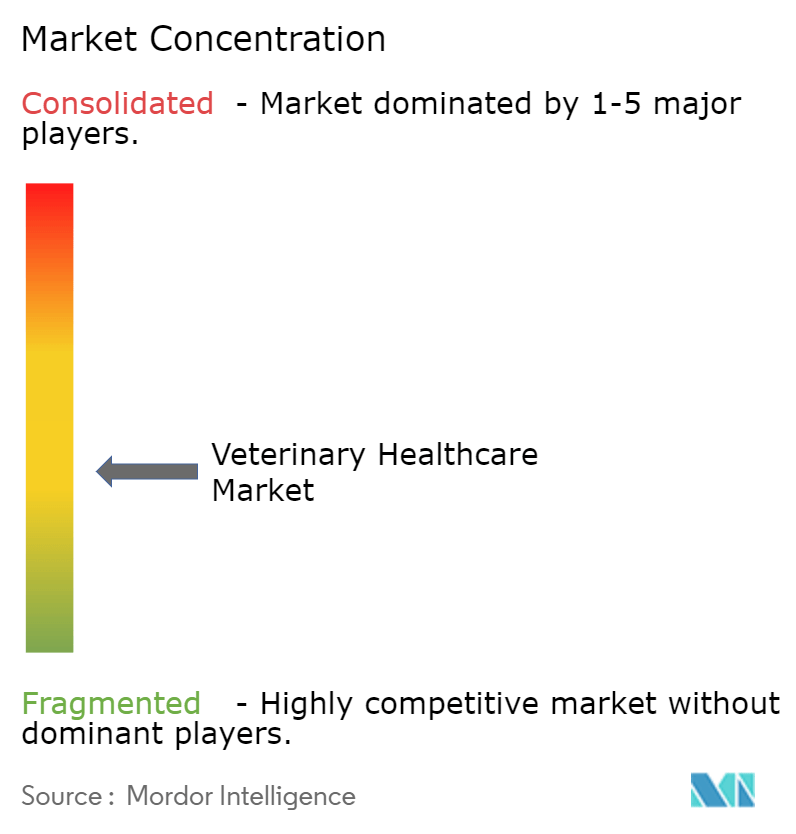
Veterinary Healthcare Market News
- January 2024: Dechra launched Cyclofin, an injectable single-dose solution for acute bovine respiratory disease (BRD). Cyclofin is aimed at BRD caused by oxytetracycline-sensitive Mannheimia haemolytica and Pasteurella multocida, where an anti-inflammatory and antipyretic effect is required.
- June 2023: Norbrook expanded its cattle health product portfolio in North America with the introduction of Tauramox (moxidectin) Injectable Solution. Tauramox was the first generic Cydectin (moxidectin) Injectable Solution for the treatment of a broad range of internal and external parasites that impact the health and performance of beef and nonlactating dairy cattle (under 20 months of age).
Veterinary Healthcare Market Report - Table of Contents
1. INTRODUCTION
1.1 Study Assumptions and Market Definition
1.2 Scope of the Study
2. RESEARCH METHODOLOGY
3. EXECUTIVE SUMMARY
4. MARKET DYNAMICS
4.1 Market Overview
4.2 Market Drivers
4.2.1 Advanced Technologies Leading to Innovations in Animal Healthcare
4.2.2 Increasing Initiatives by Governments and Animal Welfare Associations Globally
4.2.3 Increasing Productivity at the Risk of Emerging Zoonosis
4.3 Market Restraints
4.3.1 High Cost of Diagnostic Imaging Equipment and Veterinary Medicines
4.3.2 High Price of Veterinary Services
4.4 Porter's Five Forces Analysis
4.4.1 Threat of New Entrants
4.4.2 Bargaining Power of Buyers/Consumers
4.4.3 Bargaining Power of Suppliers
4.4.4 Threat of Substitute Products
4.4.5 Intensity of Competitive Rivalry
5. MARKET SEGMENTATION (Market Size by Value - USD)
5.1 By Product
5.1.1 Therapeutics
5.1.1.1 Vaccines
5.1.1.2 Parasiticides
5.1.1.3 Anti-infectives
5.1.1.4 Medical Feed Additives
5.1.1.5 Other Therapeutics
5.1.2 Diagnostics
5.1.2.1 Immunodiagnostic Tests
5.1.2.2 Molecular Diagnostics
5.1.2.3 Diagnostic Imaging
5.1.2.4 Clinical Chemistry
5.1.2.5 Other Diagnostics
5.2 By Animal Type
5.2.1 Dogs and Cats
5.2.2 Horses
5.2.3 Ruminants
5.2.4 Swine
5.2.5 Poultry
5.2.6 Other Animal Types
5.3 By Geography
5.3.1 North America
5.3.1.1 United States
5.3.1.2 Canada
5.3.1.3 Mexico
5.3.2 Europe
5.3.2.1 France
5.3.2.2 Germany
5.3.2.3 United Kingdom
5.3.2.4 Italy
5.3.2.5 Spain
5.3.2.6 Rest of Europe
5.3.3 Asia-Pacific
5.3.3.1 China
5.3.3.2 Japan
5.3.3.3 India
5.3.3.4 Australia
5.3.3.5 South Korea
5.3.3.6 Rest of Asia-Pacific
5.3.4 Middle East and Africa
5.3.4.1 GCC
5.3.4.2 South Africa
5.3.4.3 Rest of Middle East and Africa
5.3.5 South America
5.3.5.1 Brazil
5.3.5.2 Argentina
5.3.5.3 Rest of South America
6. COMPETITIVE LANDSCAPE
6.1 Company Profiles
6.1.1 Norbrook
6.1.2 Boehringer Ingelheim International GmbH
6.1.3 Ceva
6.1.4 Elanco
6.1.5 IDEXX LABORATORIES INC.
6.1.6 Innovative Diagnostics (IDVet)
6.1.7 INDICAL BIOSCIENCE GmbH
6.1.8 Merck & Co. Inc.
6.1.9 Phibro Animal Health Corporation.
6.1.10 Randox Laboratories Ltd
6.1.11 Thermo Fisher Scientific Inc.
6.1.12 Vetoquinol
6.1.13 Virbac
6.1.14 Zoetis Services LLC
- *List Not Exhaustive
7. MARKET OPPORTUNITIES AND FUTURE TRENDS
Veterinary Healthcare Industry Segmentation
As per the report's scope, veterinary healthcare can be defined as the science associated with diagnosing, treating, and preventing animal diseases. The increasing importance of the production of livestock animals is boosting market growth.
The veterinary healthcare market is segmented by product, animal type, and geography. By product, the market is segmented into therapeutics and diagnostics. By animal type, the market is segmented into dogs, cats, horses, ruminants, swine, poultry, and other animal types. By geography, the market is segmented into North America, Europe, Asia-Pacific, the Middle East and Africa, and South America. The report also covers the estimated sizes and trends for 17 countries across major regions globally. The report offers the value (USD) for all the above segments.
| By Product | |||||||
| |||||||
|
| By Animal Type | |
| Dogs and Cats | |
| Horses | |
| Ruminants | |
| Swine | |
| Poultry | |
| Other Animal Types |
| By Geography | ||||||||
| ||||||||
| ||||||||
| ||||||||
| ||||||||
|
Veterinary Healthcare Market Research FAQs
How big is the Veterinary Healthcare Market?
The Veterinary Healthcare Market size is expected to reach USD 58.30 billion in 2024 and grow at a CAGR of 6.83% to reach USD 85.14 billion by 2029.
What is the current Veterinary Healthcare Market size?
In 2024, the Veterinary Healthcare Market size is expected to reach USD 58.30 billion.
Who are the key players in Veterinary Healthcare Market?
Zoetis Inc., Boehringer Ingelheim International GmbH, Elanco Animal Health, Ceva and Merck & Co., Inc. are the major companies operating in the Veterinary Healthcare Market.
Which is the fastest growing region in Veterinary Healthcare Market?
Asia-Pacific is estimated to grow at the highest CAGR over the forecast period (2024-2029).
Which region has the biggest share in Veterinary Healthcare Market?
In 2024, the North America accounts for the largest market share in Veterinary Healthcare Market.
What years does this Veterinary Healthcare Market cover, and what was the market size in 2023?
In 2023, the Veterinary Healthcare Market size was estimated at USD 54.32 billion. The report covers the Veterinary Healthcare Market historical market size for years: 2019, 2020, 2021, 2022 and 2023. The report also forecasts the Veterinary Healthcare Market size for years: 2024, 2025, 2026, 2027, 2028 and 2029.
Veterinary Healthcare Industry Report
The Veterinary Healthcare Market is segmented by product into therapeutics and diagnostics, and by animal type into dogs and cats, horses, ruminants, swine, poultry, and other animal types. This comprehensive industry research provides an in-depth market analysis, highlighting the market size, market share, and market growth within the veterinary healthcare sector. The report also offers a market forecast outlook, presenting a detailed market review and market overview.
The industry report includes valuable industry statistics and industry trends, which are essential for understanding the market dynamics. The industry analysis covers various geographical regions, including North America, Europe, Asia-Pacific, the Middle-East and Africa, and South America. The market segmentation is thoroughly examined to provide insights into the market leaders and emerging trends.
In addition to the market data, the report includes a market outlook and market predictions, which are crucial for strategic planning. The market research encompasses a historical overview and a market forecast, ensuring a comprehensive understanding of the industry's past, present, and future. The report example and report pdf are available for further reference, offering detailed industry information and industry reports.
The veterinary healthcare market report also highlights the growth rate and market value, providing a clear picture of the industry's performance. The industry outlook is positive, with significant market growth expected in the coming years. This report is an essential resource for research companies and stakeholders looking to navigate the veterinary healthcare market effectively.



